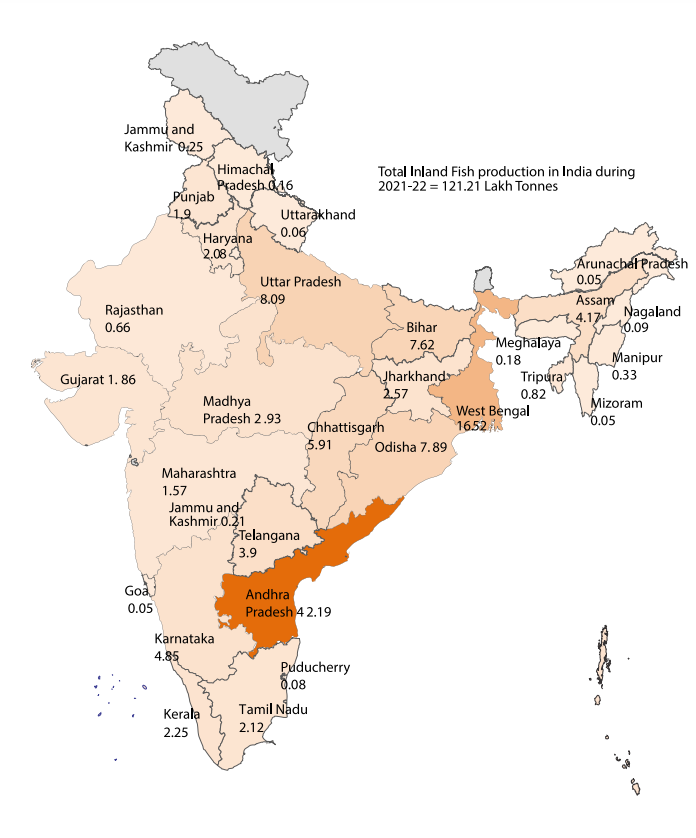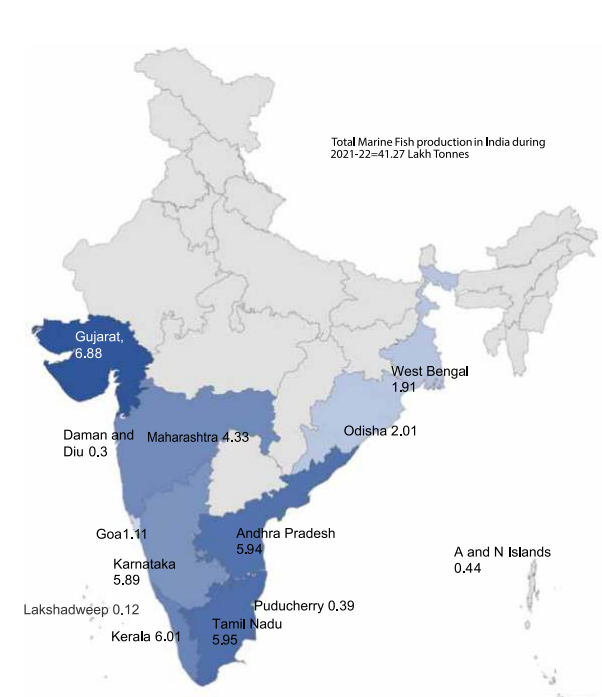Indian Economy
India’s Fisheries Sector
- 18 May 2023
- 8 min read
For Prelims: Sagar Parikrama, Pradhan Mantri Matsya Sampada Yojana, Kisan Credit Card, Indian Blue Revolution, GPS Navigation systems, Palk Bay Scheme, Fisheries and Aquaculture Infrastructure Development Fund (FIDF), Aquaponics
For Mains: Status of the Fisheries Sector in India.
Why in News?
Government’s Sagar Parikrama is an evolutionary journey envisaged in the sea across the coastal belt aiming to resolve the issues of the fishermen and other stakeholders and facilitate their economic upliftment through various government schemes and programs, including PMMSY (Pradhan Mantri Matsya Sampada Yojana) and KCC (Kisan Credit Card).
What is the Sagar Parikrama Initiative?
- About:
- Sagar Parikrama’ program envisages to cover the maritime States/UTs in a phased manner. The journey began on March 5th, 2022, from Mandvi, Gujarat.
- The journey focuses on bridging the gaps in the expectations of fisher communities, developing fishing villages, and upgrading infrastructure such as fishing harbors and fish landing centers.
- Phases of Sagar Parikrama:
- Phase I: The journey covered three locations in Gujarat - Mandavi, Okha-Dwarka, and Porbandar.
- Phase II: Seven locations were covered in Mangrol, Veraval, Diu, Jafrabad, Surat, Daman, and Valsad.
- Phase III: Coastal areas of northern Maharashtra, including Satpati, Vasai, Versova, New Ferry Wharf (Bhaucha Dhakka), and Sasson Dock in Mumbai, were part of this phase.
- Phase IV: Udupi and Dakshina Kannada districts in Karnataka were covered during this phase.
- Upcoming Phase V: Phase V of Sagar Parikrama will cover six locations: Raigad, Ratnagiri, and Sindhudurg Districts in Maharashtra, and Vasco, Maorugoa, and Canacona in Goa.
- Maharashtra, with its extensive coastline of 720 km, has immense untapped potential in the fisheries sector.
- The state ranks 7th in fish production in the country, with marine fisheries contributing 82% and inland fisheries 18%.
- Goa, with a coastline of 104 km, also plays a vital role in the marine fishery sector, providing livelihoods to many.
What is the Status of the Fisheries Sector in India?
- About:
- As the third-largest fish producer and the second-largest aquaculture producer globally, India recognizes the significance of the fisheries and aquaculture industry.
- The Indian Blue Revolution has led to a major improvement in the fishing and aquaculture industries. The industries are regarded as sunrise sectors and are anticipated to have a big impact on the Indian economy.
- In the recent past, Indian fisheries has witnessed a paradigm shift from marine dominated fisheries to inland fisheries, with the latter emerging as a major contributor of fish production from 36% in the mid-1980 to 70% in the recent past.
- The fish production reached an all-time high of 16.25 MMT during FY 2021-22 with marine exports touching Rs. 57,586 Crores.
- Top Producing States:
- Andhra Pradesh is the largest producer of fish in India followed by West Bengal.
 |
 |
- Current Challenges:
- Illegal, Unreported, and Unregulated (IUU) fishing: IUU fishing exacerbates overfishing and undermines the sustainability of the sector.
- IUU fishing involves activities such as fishing without proper licenses, using banned gear, and disregarding catch limits. Weak monitoring and surveillance systems make it difficult to combat this problem effectively.
- Inadequate Infrastructure and Technology: Outdated fishing vessels, gear, and processing facilities hinder the efficiency and productivity of the sector. Insufficient cold storage and transportation infrastructure result in post-harvest losses.
- Limited access to modern fishing technology, such as fish finders and GPS navigation systems, restricts the ability to locate fish stocks accurately.
- Climate Change and Environmental Degradation: Rising sea temperatures, ocean acidification, and changing currents have a profound impact on marine ecosystems and fish populations.
- Climate change leads to shifts in fish distribution, reduced productivity, and increased vulnerability to diseases. Pollution, habitat destruction, and coastal development further degrade marine ecosystems.
- Socio-Economic Issues: The fisheries sector in India is characterized by a large number of small-scale and artisanal fishers who face multiple socio-economic challenges.
- Low incomes, lack of access to credit and insurance, and inadequate social security measures contribute to the vulnerability of fishing communities.
- Gender disparities and the marginalization of women in fisheries also pose challenges.
- Market Access and Value Chain Inefficiencies: Despite India's significant fish production, there are challenges in accessing domestic and international markets.
- Poor post-harvest handling, limited value addition, and inadequate market linkages result in reduced profitability for fishers.
- Illegal, Unreported, and Unregulated (IUU) fishing: IUU fishing exacerbates overfishing and undermines the sustainability of the sector.
- Initiatives related to Fisheries Sector:
Way Forward
- Embrace Aquaponics: India can promote the adoption of aquaponics, a sustainable farming technique that combines fish farming with hydroponics.
- This system allows for the simultaneous cultivation of fish and plants, utilizing fish waste as a nutrient source for plant growth.
- Aquaponics reduces water usage, maximizes land productivity, and provides an additional source of income for fish farmers.
- Enhance Cold Chain Infrastructure: There is a need to improve the cold chain infrastructure to minimize post-harvest losses and maintain the quality of fish products.
- Also, there is a need to establish well-equipped fish collection centers near coastal areas and integrate them with modern storage facilities, transportation systems, and processing units.
- This will enable the efficient preservation and distribution of fish, reducing spoilage and increasing market value.
- Support Value Addition and Diversification: Encourage fish farmers to engage in value addition activities to increase their income. Provide training and financial assistance for fish processing, packaging, and branding.
- Promote the development of innovative fish-based products such as ready-to-eat snacks, fish oil supplements, fish leather, and collagen products. This will expand market opportunities and enhance the value chain.
UPSC Civil Services Examination Previous Year Question (PYQ)
Prelims
Q. Under the Kisan Credit Card scheme, short-term credit support is given to farmers for which of the following purposes? (2020)
- Working capital for maintenance of farm assets
- Purchase of combine harvesters, tractors and mini trucks
- Consumption requirements of farm households
- Post-harvest expenses
- Construction of family house and setting up of village cold storage facility
Select the correct answer using the code given below:
(a) 1, 2 and 5 only
(b) 1, 3 and 4 only
(c) 2, 3, 4 and 5 only
(d) 1, 2, 3, 4 and 5
Ans: (b)
Mains
Q. Defining blue revolution, explain the problems and strategies for pisciculture development in India. (2018)




